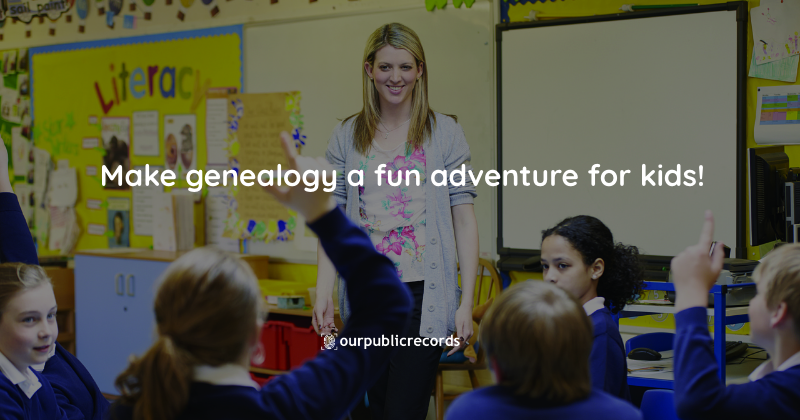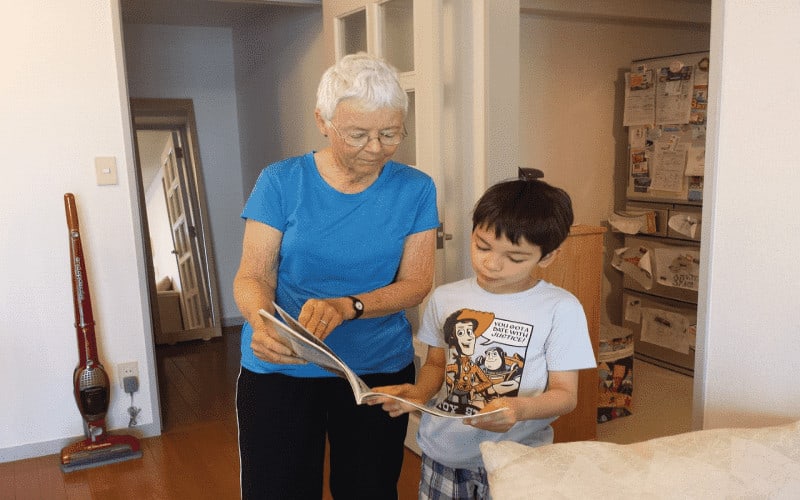UPDATED July 2024
While genealogy is often the realm of adults, kids can also benefit while having fun. The key is to find ways to include them in the search for family history details and stories, all of which can bring excitement, bolster a broader sense of self, and help develop various research and writing skills.
Whether you are a teacher, parent, grandparent, or other relative or family friend, there are a variety of ways you can spark kids’ interest and get them involved in discovering their own family history. This guide provides you with the information to help get children started in learning genealogy and also provides several resources that you can use now and later on as they make the journey through their own family history.

Introducing Kids to Genealogy and Family History
There are a variety of ways to introduce kids to genealogy and family history research. Much, however, will depend on the age of the child and whether you are a family member or teacher. Still, the following suggestions are a good place to start.
Share stories
The best way to introduce kids to genealogy and family history is with the use of stories. Storytelling captures the attention of all ages and can inspire. Present one of your personal genealogy stories, such as how your great-grandfather rode a horse to school or a great-aunt taught in a one-room schoolhouse in Alaska. Pique their interest in the process by sharing one of your own genealogical discoveries relating to that relative that you hadn’t known before. Find ways to make the stories interesting and fun to the age of the child.
Read books geared toward family history
There are a number of books available today that present genealogy and family history in a friendly, familiar way to kids. For example, Evie Finds Her Family Tree is a story showcasing a simple, fun introduction to genealogy. You can also choose books about children throughout history, such as Laura Ingalls Wilder, then segway into a conversation about family history.
Other books that can help you introduce the subject of genealogy are those that can tie into what the child is studying in school, such as a historical event. Provide book suggestions so they can discover more about those historical moments in time, then ask them to find out about any ancestors that might have lived during that period.
Show historical pictures that include children
Find historical pictures that include children, such as those showing them playing in a field, selling newspapers in the city, or any others that may spark interest. Ask the child to build a story around what he or she sees. Tailor a discussion around these photos and suggest how these might look much like what life was like for their great-great-grandparents or other relatives.
How to define genealogy and family history
You can start sharing family history with children early on and build upon that as they grow older. To start, consider the age and skill level of each child and tailor your approach accordingly. As you undoubtedly already know, children often have numerous questions that start with “why,” so you’ll want to be ready for these as well.
Resources:
Involve Children/Youth in Family History, FamilySearch
Genealogy, Kids Wordsmyth, Word Explorer Children’s Online Dictionary
Grades 3-5
For younger kids, do your best to keep it as simple as possible when explaining what genealogy is and how family history can be explored. Use words that appeal to this age group in order to capture and hold their attention and interest.
You might want to start with something like, “it is the study of your family going back through the years.” Another way is to say genealogy involves solving how everyone in the family is connected. Essentially, it is the research and discovery of finding out where their past relatives came from, how they lived, when they married, and how many children were born. Use simple examples to help bring the meaning home to them.
Resources:
Basic Genealogy for Kids (Bonnie Hinman)
Evie Finds Her Family Tree (Ashley B. Ransburg)
Grades 6-8
Defining what genealogy and family history are to children requires that you use terms they can understand. For this age group, start introducing words such as ancestor, generation, immigration, and vital records once you see they are starting to grasp what you are telling them.
Also, provide examples of how one goes about researching family history, including interviewing relatives of all ages, looking through old photographs, locating official records at courthouses, ordering military records, looking at census reports, and whatever methods you are familiar with already.
Resources:
Genealogy Glossary: Common Genealogy Terms Explained, MyHeritage.com
Genealogy Terms Explained, RootToBranches.com
Genealogy for Kids: Building a Family Tree, AAA State of Play
Vocabulary about FAMILY for children, YouTube video
What is Genealogy?, FamilySearch (YouTube video)
National Geographic Kids Guide to Genealogy
It’s All Relative: Ten Ways to Teach About Family, BusyTeacher.org
Genealogy Resources for K-12 Educators and Parents, Indiana State Library

Why is Genealogy and Family History Important to Understand?
Genealogy and family history studies are more than a game or another homework assignment. There are several reasons why they are so important for children to understand and gain an interest in pursuing.
These reasons include the following.
- For connection. Family history activities help children understand how the various generations are connected and how he or she fits within the family. This newly understood connection can lead to increased bonding with other members of the family in new ways.
- For discovery. Children will be able to identify particular characteristics, traits, or talents that they share with a grandparent or other ancestor. This revelation can be exciting, showing where there are similarities. For example, they can discover who in the family also has red hair and freckles or dimples, was left-handed, appeared studious or adventurous, or any number of other things.
- For a sense of identity. Learning more about “where they came from” can help kids foster a sense of identity and belonging to something beyond their own little world.
- For developing resilience. By learning of the many struggles and obstacles encountered by past members of the family, a child can see that getting past challenges is possible, and this will help them build resilience.
- For boosting an interest in history. Genealogy is a personalized way of sparking an interest in history in children. It provides an opportunity to learn about the world and compare the past with their present. By showing they have a personal investment in learning history, they can look at it in a whole new light.
How to get kids enthusiastic about learning genealogy
Once you introduce genealogy to children, you’ll need to find ways to get them enthusiastic about learning more. Make it real and personal for them. Here is a list of suggestions you can try, depending on the child’s age and interests.
- Share family stories. Tie family stories into something of interest to your child. If they like to be in the kitchen with you or help you cook, tell a story around your grandmother’s aprons, homemade biscuits, or other food-related topics. Another possibility is to talk about the scarcity of food, victory gardens, and rationing during WWII.
- Show family heirlooms. If you have anything passed down from an older family member, pull it out and let your child see and touch it up close. These might include a pocket watch, military medals, quilts, family bible, artwork, jewelry, vases, etc.
- Inspire them with fun activities. There are several activities that can inspire children to learn more, from photo hunts to creating profiles of a grandparent or other relative. (We share more of these below.)
- Introduce a mystery to solve. Many children love a good mystery, so introduce a hole in the family research that they can help fill in and build upon. These mysteries can be simple to complex.
- Plan a family history trip. Sit down and plan a family history trip together based upon a story you’ve told them about their ancestors.
- Give them a journal or fill-in-the-blanks book. A journal or fill-in-the-blank book will help them keep track of what they discover.
- Plan a research project to work on together. You may have a box full of old photos that need arranging and labeling, or choose to focus on one grandparent and learn all you can together by interviewing them.
Whatever you do, find a way to make it fun and show how they can become personally invested in the search and outcome.
Resources:
The Family Tree Detective: Cracking the Case of Your Family’s Story (Ann Douglas) for grades 4-8
Who Do You Think You Are? Be a Family Tree Detective (Dan Waddell), an activity book for kids
My Family and Me: A Family History Fill-In Book (Cara J. Stevens), ages 7-9
My Family Tree Workbook; Genealogy for Beginners Activity Book
My Family Legacy Journal: A Family History Record Book and Guided Time Capsule Journal for Kids and Teens, My Family Legacy Project
Youth Education Resources, American Ancestors
Family History Summer Fun for Kids: Give them the Genealogy Bug Early (Maureen Taylor for Genealogy.com)
5 Fun Activities to Inspire Your Children to Love Family History, MyHeritage Blog

Lesson Plans and Activities for Teaching Genealogy and Family History
There are so many different types of activities that children can do, either with you or on their own, to learn more about their family history. From creating family trees to interviewing elderly relatives, you’ll have plenty of options when enticing kids to become involved. Today you can also find several lesson plans that cater to genealogy for children, making it easy and creative in a variety of ways.
Always keep in mind that children have different interests and skills, so be willing to try different ones until you find what strikes a chord with your children.
Introduction to genealogy lesson plans
While you may already know of ways to entice your kids or those in your classroom to begin working on their family history, a wide variety of genealogy lesson plans are already available online. These can not only save you time but present creative activities and projects you hadn’t thought of or even knew to consider. They can also make your role in teaching genealogy methods to children easy and fun for all.
You may want to focus on different types of lessons depending on where you are at any time with the process. For example, there are lesson plans that focus on creating a family tree, traveling through history, understanding immigration, and more. You can find ones for all ages, and there’s no requirement that you be a teacher to use most of these activity ideas and lesson plans.
Resources:
Genealogy Activities for Kids!, National Archives
Kids Corner: Have fun with family history! The Family History Guide
Family Tree Lesson Plans, ThoughtCo.
Family History Lessons, Worksheets, and Activities, Teacher Planet
Family Tree Lesson Teaching Resources, Teachers Pay Teachers
Family History Stories, Kids Corner, The Family History Guide
Family tree activities
Discovering and creating a family tree is a fun activity for kids. Treat it as a puzzle to be solved to garnish more attention.
You may want to start by showing them a basic family tree drawing already filled in. From there, encourage participation by asking kids to create their own basic family tree and show them how to draw boxes that join with other boxes. For younger children, creating a list of relatives going back several decades may work better at first.
You can also find a variety of helpful family tree lesson plans and activities online.
Resources:
Free Family Tree Lesson Plans…Kids/Teens, Family History Daily
Family Tree Lesson Plans: Genealogy, ThoughtCo.
A Family Tree; TeacherVision
How to Make a Family Tree with Kids, parents.com
Little Family Tree, a genealogy app for kids with free download, teaching via interactive activities and games.
Interviewing family members activities
Introduce the activity of interviewing family members for more information on family history. Find ways to spark curiosity by providing a short list of questions for the child to ask different relatives, making it seem as if they are playing the role of a journalist and interviewing witnesses to history. These initial questions will be basic, of course, but it introduces them to the process with hopes it will catch on as an activity they eventually pursue throughout their life.
Let them also come up with a few questions on their own. These will show more about where their particular curiosities and interests lie and allow you to focus lessons going forward.
Another way to start is by asking them to first “interview” themselves. Provide a list of questions to answer. Afterward, ask a few more questions that may require them to find the answers. For example, ask if they are named after anyone in the family.
To help them stay focused, shop for a new notebook to keep their notes in. Make a collage of your family or anything that reminds them of family. Use stickers or any other aid that you know your child will enjoy using.
Resources:
My Journal: All About Me/My Family pdf, for a self-interview
Interview a Relative About Family History, Family Tree Magazine
Family History Fun: 20 Questions to Ask the Grans This Holiday, kindercare.com
Family History Interview for Kids, kidstr.com
Grandparent Family History Interview Worksheet Download
Family Interviews, Finding Your Roots Classroom
Family Interview for Parents & Grandparents, TeachBesideMe.com
Analyzing census data activities
Census records can provide a plethora of information, both definitive and puzzling. These records are a unique source for reconstructing family histories and for finding essential information. Within them, you can locate family names, birth years, birthplaces, relationships, and immigration or naturalization data.
One caveat, however, is that although the conducting of a census occurs every ten years, the categories that each one includes can differ, meaning that the data available can vary greatly.
These records aren’t the easiest to understand or get excited about when you’re young. Before rushing into the child’s own family history, consider providing them with books or other resources that show what it’s like and also activities that teach them how to do the research themselves. After that, or alongside it, work together to become familiar with what documents are available and what they can provide.
Resources:
Learning About the Census by Growing Little Leaves: Genealogy for Children
The 3rd Graders 1850 Census, ThoughtCo.
Tricking the Tallyman Picture Book by Jacqueline Davis and S.D. Schindler
10 Census Activities , Teaching Expertise
Finding Franklin: Helping Youth Use Census Records, Family Locket
Finding Franklin in a Time Machine Activity, by Lindsey Crouch on Family Locket
Little House in the Census, National Archives, Educator Resources
Resources for writing about family history
Once adults and children begin compiling data on their family history, the next question might be, what do we do with it all? The answer is to write about that family history so it can be shared and kept for future generations.
Many resources can provide ideas and different ways to write about family history, and you can use these to discuss the topic with your child. Determine what they are most excited to do and go from there. Moreso, it is a project you can work on together.
One option is to turn what you find into a book eventually, with photos and copies of important documents. You can continue to add to it as you locate more information.
You might want to choose one part of your family history to write about. For instance, if you take a trip to places where your ancestors once lived and worked, you may want to build a story around that trip and what you found.
Resources:
9 Tips for Getting Started…Writing Family History, Family Tree Magazine
Make a Kid-Friendly Family History Book, Family Locket
How to Write Your Family History, ThoughtCo.
Family History Project, Research, Biography Writing Activity (Grades 6th – 8th)
Research projects
After tackling the basics of genealogy, it’s time to move on to setting up family history research projects to get children more involved. A few ideas to assist you in getting started include the following.
- Have your child select one ancestor to focus a research project on, then assist them in establishing a plan or the steps to take to learn all they can about that person and what life was like for them.
- Focus on photo projects where you create a template and label it with various relatives. Task the child with finding photos of those relatives at a similar age. Once collected, display them side by side in the template and see if anyone looks similar.
- Provide maps for them to place stars on when they learn a new location relating to their family. This map may be of a city, county, state, region, or country. You may even want to advance to a world map, depending on your family history. With this type of research project, children will also be introduced to geography.
- Select one of the locations from the map project above to focus further research. This will expose the child to the wider world and help them learn about different cultures.
These fun suggestions are only the tip of the iceberg when it comes to genealogy projects for children. You can also find various suggestions online, as well as templates and guides.
Resources:
How to Create a Research Plan, Family Tree Resources
Create a Genealogy Research Plan: A 5-Step Example, Family Tree Magazine
Genealogy Research Plans – An Essential Tool for Busting Brick Walls, Family History Fanatics
How to Create Your Genealogy Research Plan…, Are You My Cousin Genealogy
Research Templates, American Ancestors
Family History Project, Grades 3-5, TeacherVision
A Hands-On History Family Immigration Research Project (Grades 2nd-5th)
Family History for Kids, Library of Congress Research Guides
Kid-Friendly Genealogy Activities, Projects, and Crafts (Growing Little Leaves: Genealogy for Children)
11 Creative Ways for Sharing Your Family History, The Creative Family Historian

Genealogy and Family History Teaching Resources
If you are a teacher and plan to introduce genealogy and family history projects to your students, there is an abundance of resources available to help. These resources expose students to the topic while also teaching them different skills and enhancing subjects such as history, geography, and even science.
Online databases
Online databases will be a valuable part of your family history research introduction and for continuing projects. You can find free versions and paid ones that offer more in-depth access to archival information. Many of these include guidance on how to use them for children as well.
Resources:
FamilySearch, a free online resource providing access to millions of records
U.S. Census Bureau, with access to the original form with questions for various years
USGenWebProject, a free database containing state and county genealogical and historical resources. (Also see their WorldGenWebProject for non-U.S. records)
Legacy.com, for online obituaries
Ancestry.com. containing a variety of resources, including newspapers.com and the Find a Grave database
Fold3, a database of military records
Access Genealogy, for state or topical genealogical data
Websites
Several genealogical websites exist today, some serving a dual purpose for research and for creating and uploading family trees and related historical documents. Others provide guidance on how to conduct research, what resources to consult, and more.
Resources:
AncestryClassroom™ for educators providing classroom resources
Educator Resources: Making Connections Between the Past & Present
American Ancestors Youth Education Resources
Family History by teacher planet
Genealogy and Family history projects, TPT (Teachers Pay Teachers website)
Genealogy Teacher Resources, Lesson Planet
Discovering History Through Student Genealogy Research, TeachingHistory.org
Family History Curriculum, American Ancestors
Kids Corner, Family History Guide
Family History Ideas for Children and Teens, Family Locket
Software
Another optional resource is software geared toward genealogy and family history. There are free versions and paid versions, depending on your classroom needs and budget. One of the benefits for having genealogy software is that you don’t need to be online to conduct research or work on projects.
Resources:
Family Tree Maker, with a free version (limited) or premium subscription, but the family tree builder is entirely free
MyHeritage Family Tree Builder, free software for desktop
RootsMagic, including a free version (RootsMagic Essentials) that includes the fundamentals and simple display of family trees with the use of prompts
Ancestral Quest, includes wall charts for timelines and more, calendars, and ability to publish reports and books
Gramps, free genealogy software that allows you to create large charts
Legacy Family Tree 9.0 Deluxe, to create family trees and charts while also allowing you to work offline
Libraries and archives
Beneficial sources for teaching family history and genealogy are libraries and archives. Your local public or college library may offer a special section dedicated to genealogy, which might make an ideal field trip. Otherwise, you can find robust ones online. These usually provide tutorials and guidance for all ages in how to go about searching what they have to offer, whether you are a beginner or an expert.
Resources:
National Archives, contains military records, passenger lists, naturalization records, and more.
Library of Congress, for access to a broad selection of recorded and printed materials, including city and county histories, a wide array of newspapers, and other historical resources.
New York Public Library, with massive genealogical and historical collections (including an extensive map division)
Allen County Public Library, with special collections and a Periodical Source Index containing historical and genealogical periodicals dating back to1800.
Family History Library, the world’s largest genealogical library, facilitated by The Church of Jesus Christ of Latter-day Saints in Salt Lake City, Utah.
Smithsonian Institution Ancestry Library, a subscription and fee-based resource
The Best Libraries for Genealogy Research, Family Tree Magazine
DNA testing
An advanced approach to studying geography and family history is to consider DNA testing. By combining traditional documents with a DNA analysis, more detailed and reliable conclusions can potentially be drawn. It is an exciting prospect, and can be fun and beneficial for family history mysteries and puzzle solving. There are, however, different types of testing and analysis, so be sure to understand the science behind DNA testing results and how it can benefit family history research.
Resources:
DNA Q&A: DNA Testing for Kids for Genealogy, Family Tree Magazine
Portable Genealogist: Using DNA in Genealogy, American Ancestors (Guide)
Targeted DNA Testing for Family History, Your DNA Guide
What You Will/Will Not Learn by Taking a DNA Test for Ancestry, Family History Daily
Genetic Genealogy: DNA and Family History, Library of Congress Research Guides
The 5 Types of DNA Tests for Genetic Genealogy, Family Tree Magazine
Which DNA Test is Best for Ancestry?, Your DNA Guide
Activating an AncestryDNA® Kit for Your Child, Ancestry.com
23andme, DNA kits
MyHeritage DNA Test for Ancestry

Quickly and Easily Search Almost Anyone's:

Disclaimer: We rank sites based on our knowledge and experience. Our team visits each site and evaluates each one before placing it online. Though we do accept referrals, we guarantee that the information we share is accurate and that we will only pass on information that we think is helpful to our visitors. The referral fees that we receive go to paying our team and keeping our website operational.
Opt Out Process: If you use our site and do not want to share your personal and/or confidential information with anyone else, please visit our Opt Out page to learn more about the process. We give you the option of removing your information from our site.
OurPublicRecord.Org is a privately owned and operated website and is NOT affiliated with the US Government or any law enforcement agency.